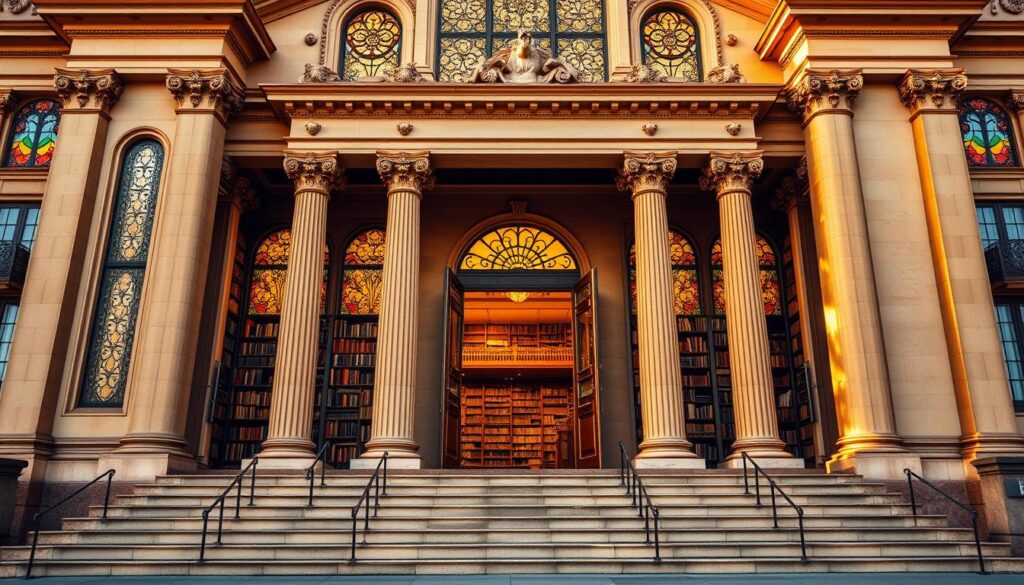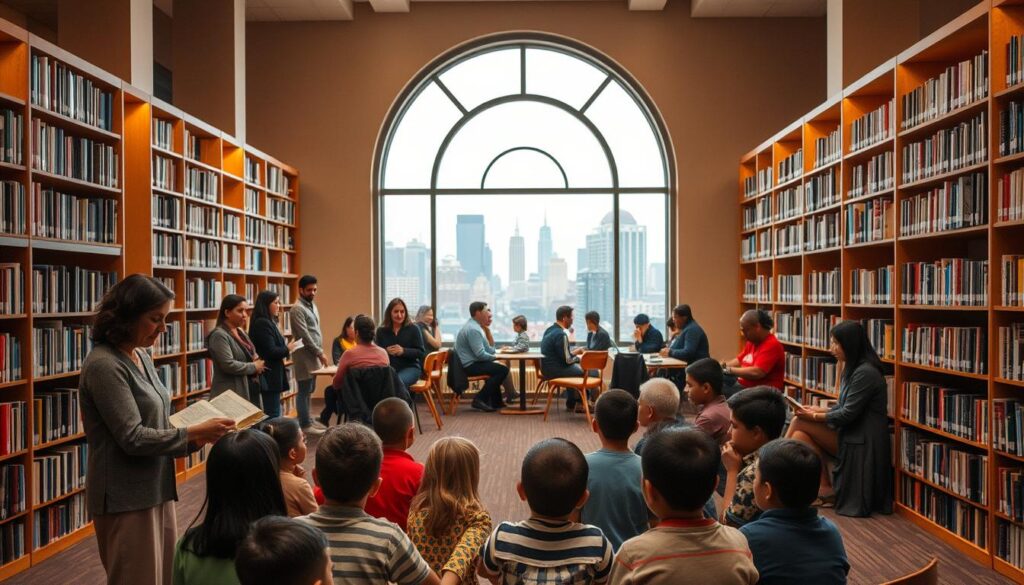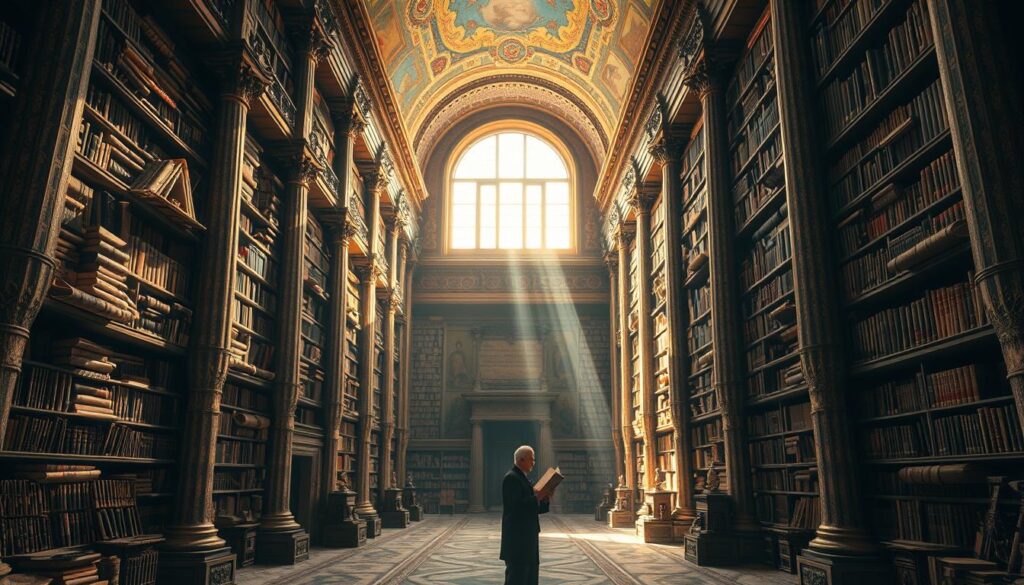A library dating to the 7th century BCE represents the oldest known such institution in history. Such institutions have accumulated valuable knowledge and cultural materials for over thousand years which remains fundamental to our understanding of the world.
Modern educational establishment and architectural triumph
The modern educational establishment and architectural triumph that libraries have become originated from ancient archives serving as library systems. The Library of Congress and Boston Public Library serve as both storage facilities and landmarks that represent human accomplishments in the world.
The combined history and artistic value present in library collections forms a tale for viewers. People can view historical events through both special collections of ancient manuscripts and digital archives that give modern users access to the past.
Key Takeaways
- For centuries libraries have served as organizations which safeguard knowledge dating back to the original libraries of ancient times.
- Education institutions as well as architectural wonders describe these establishments.
- The Library of Congress serves as one of many famous library institutions which maintain vast cultural importance.
- The current library concept joins traditional collection storage with modern technological innovations.
- Exploring these public spaces allows people to establish special ties with historical and cultural aspects.
The Rich History Behind Historic Libraries
Early occurrences of library history stem from ancient times when knowledge began to accumulate and maintain its existence. The original archives functioned as more than mere repositories since they embodied human search for knowledge while striving to comprehend the world.
Ancient Beginnings and Early Archives
The earliest well-documented library existed as the Library of Ashurbanipal which rose in Nineveh around 7th century BCE. Thousands of cuneiform tablets occupied the Library of Ashurbanipal and detailed literature together with scientific subjects. The establishment proved beyond doubt how active intellectual life had become during that historical period.
Ancient Rome incorporated libraries which emerged as facilities open to its public community. These constructed buildings received funding from wealthy patrons together with emperors which allowed scholars and citizens to access them. People gathered various items in these collections to promote both cultural growth and knowledge acquisition beyond books.
Evolution Through the Centuries
The Renaissance era introduced major developments to library institutions. The reinvention of classical literature together with printing machinery resulted in a rapid expansion of available knowledge. More library collection volumes led libraries to transition into multi-purpose centers for art and scholarly research.
The public library received its first definition during the 19th century. Such institutions emerged during that period to operate as community-serving facilities providing books and educational materials to everyone. The evolution established a fresh era in library historical development.
Modern technology connects with library tradition as institutions advance their operations into the present day. These spaces continue to be essential educational facilities because they execute both history preservation and future-oriented activity.
Historic Libraries: Visiting Repositories of Knowledge
The space conceals lasting wisdom through several centuries of accumulation. A library hall walk will expose you to an environment filled with narratives presented by both books and ancient artifacts. These institutions serve as more than historic structures because they maintain their status as alive cultural and historical monuments.
Library of Congress
The Library of Congress provides visitors with a transformative space that stuns everyone who enters. The institution presents rare manuscripts and ancient texts among their carefully selected collections as well as works of art. Every displayed artifact delivers knowledge and artistic elements that develop an intellectual connection between visitors and history.
The majority of public libraries enable their patrons to enjoy free tours together with exhibitions. These facilities welcome guests to see their collections ranging from historical vintage books to their contemporary electronic archives. These buildings give visitors the chance to understand how knowledge unites with creativity and scholarship within educational institutions.
Walking into a library creates an educational sanctuary available for everyone between researchers and explorers. The presence of old paper aromas merges perfectly with the low background noises found within these places to create an unforgettable experience. The places serve as everlasting testimonies to how knowledge transforms our existence and guides our human universe.
Architectural Masterpieces of Public Libraries
The humble public library features beyond its rows of books to manifest as true architectural achievements. Over time the designs selected for libraries developed through cultural and intellectual activities that merged artistic components alongside practical elements. Human creativity along with persistent knowledge have led to the creation of magnificent public libraries featuring grand exteriors and complex interior designs.
Renaissance Revival and Italian Influences
Library architecture underwent permanent transformation as a result of the Italian Renaissance. The Library of Congress Thomas Jefferson Building presents inside viewers with ornate columns along with domed ceilings while offering elaborate exterior decorations. Symmetry along with grandeur were the elements that inspired these architectural features.
These spaces receive decoration through their symbolic sculptures and intricate artistic elements which document cultural and intellectual beginnings. Through its Renaissance revival architectural approach the institution simultaneously improves user visits while signifying its role as a vital historical artifact.
Modern Visions in Classical Styles
Numerous contemporary libraries transform classical design features into contemporary variations. Historical design grandeur remains unchanged in these constructions which accept innovative materials and technology systems. The New York Public Library has combined its traditional Beaux-Arts entrance with modern technological infrastructure.
Such architectural collisions of new and old elements merge into useful and innovative spaces. These architectural approaches maintain both library usefulness in modern times and preservation of their historical elements.

Renaissance Revival and Italian Influences
Library architecture underwent permanent transformation as a result of the Italian Renaissance. The Library of Congress Thomas Jefferson Building presents inside viewers with ornate columns along with domed ceilings while offering elaborate exterior decorations. Symmetry along with grandeur were the elements that inspired these architectural features.
These spaces receive decoration through their symbolic sculptures and intricate artistic elements which document cultural and intellectual beginnings. Through its Renaissance revival architectural approach the institution simultaneously improves user visits while signifying its role as a vital historical artifact.
Modern Visions in Classical Styles
Numerous contemporary libraries transform classical design features into contemporary variations. Historical design grandeur remains unchanged in these constructions which accept innovative materials and technology systems. The New York Public Library has combined its traditional Beaux-Arts entrance with modern technological infrastructure.
Such blending of modern elements with classic structures produces multifunctional areas that stimulate everyone using them. The preservation technique maintains modern library importance by preserving their historical architectural significance.
Gutenberg Bible
The Gutenberg Bible stands as a prominent historical treasure among all artifacts. The Gutenberg Bible became the first printed book of the printing revolution when the printers finished their work in the 15th century. Any library that owns one treasures this artifact because of its scarce nature and highly important historical background.
The institution that holds this masterpiece includes both the Library of Congress along with Yale’s Beinecke Rare Book & Manuscript Library. The academic world together with the scholarly community shares a fascination for this pages because they reflect the historical advancement of literature and knowledge.
Illuminated Manuscripts and Unique Artifacts
Part of these collections features illuminated manuscripts which stand as cherished highlights. The handmade masterpieces contain gold and bold colors which demonstrate the artistic progress of bygone eras. These items demonstrate both the hard work of medieval scribes together with artistic dedication.
Compound artifacts need expert protection for preservation. Advanced preservation methods that libraries use defend the collections from degradation ensure their availability for upcoming generations to access. Protecting cultural heritage represents a vital goal to which groups around the world contribute.
These collections have been inspiring readers since premodern times until present modern works. These essential resources provide academic researchers and cultural explorers essential access to intellectual pieces from all across the world.
| Feature | Historical Libraries | Modern Libraries |
|---|---|---|
| Design Style | Renaissance Revival, Italian Influence | Classical Reinterpretation, Minimalism |
| Key Elements | Ornate Columns, Domes, Statues | Innovative Materials, Technology Integration |
| Purpose | Cultural Symbolism, Intellectual Pursuit | Functionality, Accessibility |
Iconic US Libraries: A Visual Tour
American public libraries serve as historical landmarks which enable people to visit epochs spanning from previous times until today. These institutions unite impressive architecture with essential cultural value to provide visitors atmospheres that enable them to explore knowledge in beautiful surroundings.
Library of Congress and Historic Halls
The Washington D.C. Library of Congress exists as a remarkable architectural tribute to history. The majestic halls contain marble floorings together with grand columns and detailed mosaic decorations. One stands in awe when visiting the Main Reading Room because of its magnificent domed ceiling combined with elaborate decorative elements.
The library collection exceeds 170 million items where one can find rare manuscripts and historical documents. People can witness how literature empowers and modifies our world through its exhibitions combined with their free general access tour services.
New York Public Library’s Signature Spaces
The New York Public Library stands as an artwork of architecture alongside other landmarks. Visitors find the Rose Main Reading Room most captivating because of its elegant high ceiling and decorative chandeliers as well as wooden seating areas. Readers and scholars have found solace in this room throughout more than a century.
In the middle of the urban center stands this municipal library which provides cost-free historical information and architectural tours about its past and structural beauty. Every feature of this establishment leads back to the enduring tale of knowledge preservation through cultural dedication.
Public libraries perform dual functions by preserving history but still meet current community requirements. All visitors from scholars to casual guests can find unmatchable encounters when they walk through these sacred places.
The Evaluation of Cultural Significance in Libraries
Communities have relied on libraries for decades and the institutions serve functions that surpass book collections. These establishments exist as alive centers that promote learning together with creative activities combined with community connections.
The local culture benefits from libraries because they organize events and distribute educational materials.
Community Hubs and Educational Resources
Public libraries operate as places which welcome individuals from any age group. The library programming schedule includes workshops lectures and exhibitions to create enriching activities that benefit community activities. Public libraries organize child coding instruction programs along with book discussion meetings for adults while displaying local art exhibitions.
Educational programs at libraries establish learning opportunities that unify different community members together. The facilities at these public spaces provide members of the community with belonging while inspiring conversation. Libraries function as secure communities that welcome every person to pursue their interests and develop their understanding.
Transforming Libraries into Learning Centers
The modern library offers its members enhanced educational functionality by serving as an interactive learning center. The facilities of modern libraries include online resources and creative areas alongside 3D printing equipment. The process of evolution keeps libraries up to date with the quick pace of contemporary society.
Entrepreneurs at the Chicago Public Library gain access to a selection of tools and technological resources for developing their business. The program enables initiative by letting residents convert their innovative concepts into practical outcomes.
The modern library includes rare manuscripts and advanced technology while it remains a source of inspiration for all its visitors. Buildings serve as the fundamental communities’ centers where continuous growth and relationship development continue for future populations.
Ancient Library Origins and Roman Influence
Through its control the Roman Empire became instrumental in developing the principles of public library systems. These facilities maintained books and simultaneously expressed imperial dominance and cultural advancement. The institutions transferred personal collections into public knowledge resources for wider community access.
Public Collections in the Roman Empire
During the period of Augustan rule the Roman Empire established its inaugural collection of public libraries. The institutions maintained holdings of Greek and Latin writing content which represented the double cultural history of the empire.
The Library of Celsus at Ephesus along with similar libraries transformed into educational centers that academics and scholars traveled worldwide to visit.
Public libraries received their initial funding from imperial supporters. Wealthy citizens along with emperors contributed their resources to construct these buildings so they both served their intended purpose and displayed great magnificence. The patronage of wealthy citizens and emperors built up libraries as public areas for citizens to read philosophy and literature.
Imperial Patronage and Architectural Grandeur
Roman libraries were architectural marvels. The structures featured rooms with high ceilings as well as Corinthian columns and detailed relief decorations. Architectural grandeur resulted from the combination of marble facades and mosaics tile work thus symbolizing the imperial wealth of this sophisticated empire.
The assembled reading materials functioned as political instruments above being nothing more than books. Through their activities to develop education and culture emperors simultaneously increased their power and strengthened their relationships with their constituents. Rome established libraries as formal exhibits of its dedication to learning which served to shape human history.
The memory of humanity exists within libraries because they maintain past wisdom for future societal advantage.
People today still receive inspiration from the enduring achievements of Roman libraries. Current public institutions use the integration between architectural innovation and public accessibility as their ongoing model. The historical spaces teach us about the preeminent value of knowledge and how it creates transformations within cultures.
Modern Innovations Inspired by Historic Libraries
Modern institutions of knowledge attempt to redefine how we organize and use learning spaces that nurtures creative exploration. Advanced design techniques meet traditional heritage elements to form these institutions which borrow from classical traditions.
Modern libraries showcase two extreme trends in architectural design through minimalist interiors and grand ornate buildings because they want to both resurface ancient traditions and welcome future technologies.
Futuristic Designs in Contemporary Spaces
The libraries of Stuttgart City and Tianjin Binhai adopt innovative architectural structures which advance the boundaries of their designs. Visitors seeking knowledge enter a peaceful space in the Stuttgart City Library because its all-white design and geometric elements unite within its space. An innovative touch through converging books and bright illumination defines the design concept of Tianjin Binhai Library.
Modern design spaces utilize marble and glass materials to develop openings and vibrant illumination among the rooms. Operating as both practical and inspiring spaces libraries prove to people that they appear beautiful while providing essential services.
Minimalism Versus Ornate Heritage
Libraries exist today as either modern minimal spaces or as traditional architectural jewels with classical authenticity. Diverse contemporary library designs become apparent through their differing styles. A minimalist library design features pure lines combined with vacant areas to establish a peaceful environment for learners who need to think and study.
Libraries with decorative architecture present extensive decorative elements alongside grand staircases together with significant statues among their featured design elements. Different architectural elements in the buildings recognize the traditional role of libraries in cultural intellectual power throughout history.
Libraries keep their cultural importance through strikes between established methods and modern concepts which protect them for today’s fast-moving world. Community residents rely on these institutions to perform as essential resources which combine traditional methods with modern approaches.
![]()
Libraries as Sanctuaries of Learning and Culture
Timeless temples exist in the form of libraries which unite creativity with culture and community under their single structure. The structures host more activities than architectural structures because they welcome people who advance their education and enhance their knowledge exploration.
The rich history of the New York Public Library coexists with the creative aesthetic of modern library facilities to establish a vibrant connection that enthuses all visitors.
Spaces for Creative and Intellectual Growth
The creative exploration of imaginative ideas as well as intellectual discovery form the core purposes of library building design. The reading room at New York Public Library generates an inspired environment through its tall ceilings and gentle illumination. The space layout promotes users to pursue research combined with book exploration and mental growth.
The contemporary library design incorporates venues with clear space arrangements together with versatile seating setups which make space for innovative cooperation.
The rooms within these educational spaces adjust their layout to best suit the requirements of their visitors for either private study space or public workshop areas. These spaces serve as wells for conceptual growth alongside thriving supporting networks for their communities.
Art, Architecture, and Public Engagement
The design elements within a library have a substantial effect on its cultural impact on the community. Through architectural features such as impressive staircases as well as statues that carry meaning and decorative façades structures convey human accomplishments to viewers. The contemporary architectural rendering of the modern Library of Alexandria connects its historical past with modern aesthetics.
The library deliveries its educational mission alongside visual art and historical artifacts which create a breathtaking educational-beauty combination. These aesthetic attributes convert libraries into stunning establishments which welcome all visitors to dive into their contents
Present-day libraries develop by uniting traditions with modernized elements. The modern library keeps its status as an essential community asset which allows people to trace their history and create paths of development. Libraries function as safe spaces where every person can find either educational resources or solitude to think.
Time has been dedicated to protect historic libraries as guardians of cultural heritage for future generations.
Historic libraries become cultural heritage protectors because they uphold historic stories to assure their availability for upcoming generations. Buildings that house libraries stand as gateways to human creativity which illuminates intellectual pursuit. The protection of these establishments guarantees the preservation of time-tested knowledge accessible to everyone.
The safety of these precious cultural assets depends heavily on restoration projects intervened with their preservation. The combination of degraded facilities and weather hazards creates notable difficulties for those structures. The Library of Alexandria safeguards its valuable collection using state-of-the-art climate management technology.
Digital archives
Digital archives serve as a tool for protecting the unabridged access to important historical records. The digital conversion of manuscripts together with books enables libraries to provide safe study conditions for delicate items. Every effort to combine traditional doctrines with modern technological capabilities ensures that the achievement history survives into the present day.
Public initiatives are equally important. The funds secured through community engagement in fundraising along with awareness raising will help maintain such facilities for the future. All donations made toward preserving our cultural heritage make individual contributions that lead to a shared accomplishment.
The continuous inspiration from library establishments remains an ongoing phenomenon across various cities worldwide. Our country has made the protection of these locations both obligatory and essential since it highlights our collective heritage. Our backing of these initiatives guarantees that upcoming generations will step into these institutions to discover the realms of discovery which reading brings.

Conclusion:
Human advancement owes its progress to libraries which preserve information starting from historic manuscripts to electronic databases. Buildings represent only some aspects since libraries function as historical reminders plus intellectual progress bases. During centuries these institutions transformed into beautiful architectural masterpieces that serve their purpose.
The historical Library of Alexandria remains as a vital monument to human knowledge protection. People experience reverence and awe when they see their grand design layouts which incorporate statues as well as sophisticated details. Every urban community maintains a section of the ancient written tradition through its library establishment.
Contemporary libraries maintain their adaptation by providing classic along with contemporary library materials and resources. The facilities serve three main functions by providing learning opportunities while promoting cultural solidness and safeguarding our historical background. When people explore these valuable resources they become linked to the history of the past as they help build the future direction.
The society benefits tremendously from these essential institutions – therefore we must provide them with our support. These facilities extend beyond being mere libraries because they represent the vital core linking past and future through the lasting characteristics of knowledge and culture.




